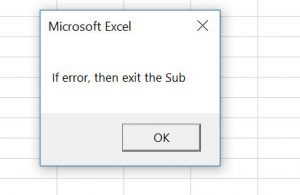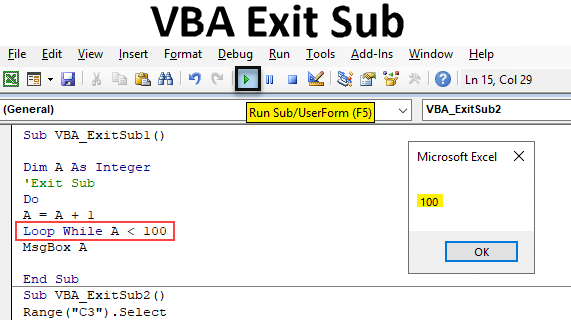

The On Error Resume Next construct may be preferable to On Error GoTo when handling errors generated during access to other objects.

An On Error Resume Next statement becomes inactive when another procedure is called, so you should execute an On Error Resume Next statement in each called routine if you want inline error handling within that routine. You can place the error-handling routine where the error would occur rather than transferring control to another location within the procedure.

This statement allows execution to continue despite a run-time error. On Error Resume Next causes execution to continue with the statement immediately following the statement that caused the run-time error, or with the statement immediately following the most recent call out of the procedure containing the On Error Resume Next statement. Notice that the On Error GoTo statement traps all errors, regardless of the exception class.
#Excel vba on error exit code#
' Code for handling the error is entered here. If (TypeOf Err.GetException() Is DivideByZeroException) Then The following example shows how these features can be used with the existing exception handling support: On Error GoTo Handler This takes a single parameter that is the exception instance to be thrown. In order to support the raising of exceptions of derived exception types, a Throw statement is supported in the language. Throw StatementĪn error that is raised with the Err.Raise method sets the Exception property to a newly created instance of the Exception class. The error message associated with Err.Number is contained in Err.Description. The property values in the Err object reflect only the most recent error. The routine should test or save relevant property values in the Err object before any other error can occur or before a procedure that might cause an error is called. Number PropertyĮrror-handling routines rely on the value in the Number property of the Err object to determine the cause of the error. It is a section of code marked by a line label or a line number. Once an error is handled by an error handler in any procedure, execution resumes in the current procedure at the point designated by the Resume statement.Īn error-handling routine is not a Sub procedure or a Function procedure. If no such error handler is found, the error is fatal at the point at which it actually occurred.Įach time the error handler passes control back to a calling procedure, that procedure becomes the current procedure. If the calling procedure's error handler is also active, control passes back through previous calling procedures until an enabled, but inactive, error handler is found. If the calling procedure has an enabled error handler, it is activated to handle the error. Control returns to the calling procedure. If an error occurs while an error handler is active (between the occurrence of the error and a Resume, Exit Sub, Exit Function, or Exit Property statement), the current procedure's error handler cannot handle the error. An "active" error handler is an enabled handler that is in the process of handling an error. For more information, see Statement.Īn "enabled" error handler is one that is turned on by an On Error statement. We recommend that you use structured exception handling in your code whenever possible, rather than using unstructured exception handling and the On Error statement.


 0 kommentar(er)
0 kommentar(er)
